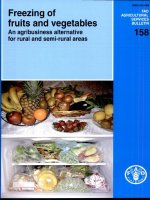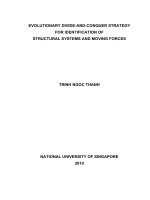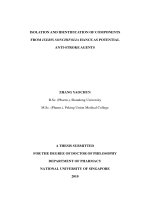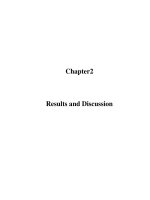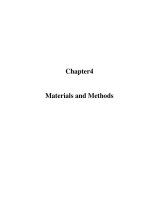Identification of chemical content of fruit and peel’s extract of some varieties’ of pomegranate (Punica granatum L.)
Bạn đang xem bản rút gọn của tài liệu. Xem và tải ngay bản đầy đủ của tài liệu tại đây (623.19 KB, 9 trang )
Int.J.Curr.Microbiol.App.Sci (2019) 8(5): 734-742
International Journal of Current Microbiology and Applied Sciences
ISSN: 2319-7706 Volume 8 Number 05 (2019)
Journal homepage:
Original Research Article
/>
Identification of Chemical Content of Fruit and Peel’s Extract of Some
Varieties’ of Pomegranate (Punica granatum L.)
Farogat Sh. Ergasheva1*, Khabibjon Kh. Kushiev1, Alimjаn D. Matchanov2,
Uchkun J. Ishimov2, Khushmatov S. Shunkor3 and Pozilov K. Mamirjon3
1
The Faculty of Natural Sciences of Gulistan State University, Gulistan city,
Republic of Uzbekistan
2
Institute of Bioorganic Chemistry of Academy of Science of Republic of Uzbekistan, 3Institute
of Biophysics and Biochemistry of National University of Uzbekistan, Tashkent city,
Republic of Uzbekistan
*Corresponding author
ABSTRACT
Keywords
Pomegranate,
Extract, The fruit
peel, Vitamins,
Macroelements,
Microelements
Article Info
Accepted:
10 April 2019
Available Online:
10 May 2019
The goal of this research work is analysis of chemical compounds of extract of fruit and
peel of some local varieties pomegranate ("Qora qayim", "Qizil anor", "Oq
dona/Tuyatish", "Achchik dona"). The experiments were carried out by using methods of
standard chemical synthesis. In the ethanol extract (70%) of the fruit peel of varieties
"Qora qayim", "Qizil anor", "Oq dona/Tuyatish", "Achchik dona"were identified vitamins
A (0.015–0.063 mg/100 ml), B1 (0.034–0.064 mg/100 ml), B2 (0.024–0.052 mg/100 ml),
B5 (0.023–0.038 mg/100 ml), B6 (0.025–0.082 mg/100 ml), C (4.805–11.546 mg/100 ml),
and E (0.014–0.612 mg/100 ml), as well as macronutrients (K, Ca, Mg, Na) and
micronutrients (Mn, Zn, Cu, Se). The results show that the rind of pomegranate fruits
(Punica L.) is a polycomplex property by chemical composition and a promising agent in
the development of pharmacological drugs.
fruits are widely used in various juices, meat
and fish processing products, pharmacology,
and other medicinal products (Cowan, 1999;
Dahanukar et al., 2000; Das et al., 2009;
Radhika et al., 2011).
Introduction
Pomegranate fruits have been widely used in
ancient plants as a source of nutritional value.
Pomegranate fruits are attracted by
researchers' interest as they are rich for
biologically
active
compounds,
microelements and vitamins. The products
obtained from the processing of pomegranate
Although the pomegranate fruit has been used
in the treatment of some internal diseases and
skin rashes in folk medicine, the seeds and
734
Int.J.Curr.Microbiol.App.Sci (2019) 8(5): 734-742
sheaths remain as residuals (Kovalevskaya et
al., 2015). Pomegranate fruit contains 85.4%
of water, 10.6% of total sugar, 1.4% of pectin
and 0.2–1% of polyphenol compounds
(Prakash and Prakash, 2011).
pomegranate varieties’ (Punica granatum L.)
produced in the Mirzachul oasis and the
amount
of
vitamins
and
macro–
microelements contained in the fruit and
peel’s.
Pomegranate juice is rich with 85.4% of
water, 1.4% of pectin, 0.2–1% of polyphenol
compounds, and 10.6% of carbohydrates,
while the sheath is rich with citric acid and
colorful dubile substances (Prakash and
Prakash, 2011). Also, the sheath of
pomegranate is rich for pectin composition.
Pomegranate seeds contain a large amount of
fat, about 67% of which are unsaturated fatty
acids, of which 40% are linoleic acid. The
pomegranate seeds are rich in tocopherol
(Gafizov and Semochkina, 1995; Ferrari et
al., 2010; Vroegrijk et al., 2011; Afshar et al.,
2011; Prakash and Prakash, 2011; Valero et
al., 2014; Basiri, 2015; Gafizov, 2015;
Kovalevskaya et al., 2015).
Materials and Methods
In the researches, some of the local varieties
of pomegranate (Punica L.) ("Qora qayim",
"Qizil anor", "Oq dona/Tuyatish", "Achik
dona") cultivated in Syrdarya region of the
Mirzachul oasis of Uzbekistan were selected
as the object.
Extraction and analysis of ethanol (70%)
extract from the fruit and sheath of
pomegranate (Punica L.) varieties is carried
out jointly with the staff of the Laboratory of
chemistry of lower molecular compounds at
the Institute of Bioorganic chemistry.
High–performance liquid chromatography
(HPLC) method of determining the vitamin D
group (thiamin – B1, riboflavin – B2,
pyrotoxin – B6, pantothenic acid – B5, biotin,
cyanocobalamin – B12, folic acid) has been
reported that it is possible to obtain reliable
results (Amidzic et al., 2005; Aslam et al.,
2008; Sami et al., 2014).
It is worthwhile to note that based on the
analysis of literature on the pomegranate's
chemical composition, the amount of organic
and inorganic substances in the juice, seed
and crust of pomegranate fruits depends on
the region and soil–climatic conditions.
The results obtained in connection with a
wide range of physiologically active
substances in the juice of pomegranate, peel’s
and seeds (Aviram et al., 2006; Sreekumar et
al., 2014; Akhavan and Barzegar, 2017;
Qamar Abbas et al., 2018) show that broader
and deeper research is still needed.
In the experiments, the method of
identification of vitamins within the ethanol
(70%) extract of native varieties of
pomegranate (Punica anata L.) was carried
out by using the standard method, published
in the literature (Ellekr et al., 2004).
Based on the above–mentioned opinions, it is
important to study some of the varieties of
pomegranate (Punica granatum L.) fruits and
peel’s chemical compounds vegetated in the
Mirzachul oasis, which occupies a large area
in the Central Asian region, and the fruits and
peel’s. Therefore, the purpose of this research
was to compare the varieties of certain
This method (high accuracy: p<0.05) was
based on the extraction of vitamins in an
organic solvent medium and concentration of
extracted extracts in the chromatographic
method by fractionation of C18 in the method
of HPLC and at the next stage, analysis of
fractions
by
fluorescence
and
spectrophotometric detectors found. The
735
Int.J.Curr.Microbiol.App.Sci (2019) 8(5): 734-742
Detection wavelengths – 204 nm, 245 nm,
254 nm, 290 nm and 325 nm.
detection of each individual substance in the
content of the test sample contained in the test
sample was determined by comparing the
detection in the chromatographic system to
the standard sample size and area of the
"peaks" corresponding to the wavelength
(Ellekr et al., 2004; Rowayshed et al., 2013).
Experiments were carried out by using
Agilent (USA) high–performance liquid
chromatography equipment equipped with
autosampler "Agilent Technologies–1200"
(Fig. 1).
The vitamins A and E were found to be 325
nm and 290 nm respectively, according to the
standard method (Sami et al., 2014).
Determination of macronutrients and
micronutrients content of pomegranate
(Punica granatum L.) fruits and peel’s
In experiments, the pomegranate (Punica
granatum L.) fruit and inductively coupled
argon plasma were analyzed by Mass–
spectrometry method (ISP–MC NEXION–
2000, Perkin Elmer USA) (Rowayshed et al.,
2013).
The sequence of methodologies for
quantitative analysis of vitamins in HPLC is
described in detail in the following manual
(Ellekr et al., 2004).
In the experiments, vitamins belonging to
group B were determined by standard
methods (Aslam et al., 2008; Ringling and
Rychlik, 2013).
The samples were sampled on an analytical
scale and placed in autoclave with teflon and
the acids breakdown method was used. The
shredding works were performed for 35 min
at the "Berghof" microwave breaking device
(Germany) with MWS–3 + software. The tube
was transferred to the measuring tubes as the
amount of the resulting solution. Mass
spectrometer was analyzed for autosampler
analysis. The analysis was based on the
multielement
standard.
The
standard
concentration of calibration was at
concentrations of 10 mg/l (10 ppb) and 100
mg/l (100 ppb). Conditions of analysis:
generator (plasma) voltage – 1500 W; flow
speed – 0.7 ml/min.; nebulizer – 0.8 l/min.;
argon (plasma) – 15 l/min.
The pomegranate (Punica L.) extract was
powdered and dissolved in 80 mg of 5 ml of
0.1 normal H2SO4 solutions and stored at
+25°C for 100 minutes. In the next step, using
sodium acetate, pH=2.5 was filtered and
prepared in 5 ml test sample in distilled water.
Standard vitamin specimens were prepared
using the appropriate methods to compare
(Aslam et al., 2008; Ringling and Rychlik,
2013).
Chromatographic process at +25 °C, HPLC–
based diode matrix (DAD) detector for firm
"Agilent Technologies–1200" (USA) was
performed on high–performance liquid
chromatography device. Chromatography
conditions: column type – Eclipse XDB C18;
the length of the column is 150×4,6 mm;
sorbent volume – 5 micrometer; flow rate – 1
ml/min. Melting system: A: acetonitrile; B:
Acetate buffer (rN–3.0–3.5). Chromatography
conditions gradient % A/min: 0–2%/0–4 min;
2–20%/4.1–8 min; 20–0%/8.1–10 min.
Solvents and chemicals
In the experiments were used methanol,
acetonitrile ("Sigma–Aldrich", Germany) for
the liquid chromatography technique (mobile
phase). Standardized samples were used as
standard vitamins (retinol acetate (С22Н32О2),
α–tocopherol acetate (С31Н52О2), pyridoxine
hydrochloride, riboflavin, thiamine, ascorbic
acid, etc. ("Sigma–Aldrich", Germany).
736
Int.J.Curr.Microbiol.App.Sci (2019) 8(5): 734-742
In addition, using HPFC method, juice of
varieties of pomegranate includes vitamin A
(44–236.1 mg/100 ml), vitamin B1 (30.8–
124.1 mg/100 ml), vitamin B5 (114.9–301.5
mg/100 ml), vitamin B6 (12–90.3 mg/100 ml)
was found to be vitamin C (10.4–35.4 mg/100
ml) (Akhavan and Barzegar, 2017). In the
next series of experiments, the yield of local
varieties of pomegranate varieties and
macroelements and microelements in the
sheath was analyzed as well (Table 2).
Data analysis
The results were statistically processed by a
special software package OriginPro v. 8.5
SR1 (EULA, USA). The results of
experiments
processed
mathematically–
statistically using standard biometric methods
(Lakin, 1990).
Results and Discussion
The sheath and fruits of the first varieties of
pomegranate
were
separated
and
mechanically mixed in sterile conditions. The
weighted samples weight (5–10 g) were
measured ("CAS_CUW220H"; China, the
accuracy was 0.01 g) and the tubes (V=300
ml) were added and 50 ml of ethanol solution
(70%) was added. Tubular magnetic fridge
(Russia) 60 min. It was stored at +110 °C
under temperature conditions. In the next step
the mixture was extracted 2 times in 25 ml of
ethanol solution (70%). The filtrate was
dissolved in 100 ml of ethanol (40%) and was
incubated for 10 min at 7000 rpm. during
centrifugation. The deposition was removed
and the resulting solution was used as a
porcine extract in the next chemical analysis
(Fig. 2).
It is necessary to mention that during the
conducted researches in the content of
pomegranate peel’s (Punica Granatum L.)
there were determined the followings Са
(338.5 mg/100 g), K (146.6 mg/100 g), Na
(66.43 mg/100 g), P (117.9 mg/100 g), Fe
(5.93 mg/100 g), Zn (1.01 mg/100 g), Mn (0.8
mg/100 g), Cu (0.6 mg/100 g), Se (1.03
mg/100 g) (Rowayshed et al., 2013).
When analyzing the chemical composition of
23 types of commercial fruit juices by some
researchers, K (209.3–251.7 mg/100 ml), P
(9.3–15.1 mg/100 ml), Ca (1.1–14.9 mg/100
ml), Mg (2.1–10.4 mg/100 ml) and Na (2–
12.8 mg/100 ml) were found (Eksi and
Ozhamamci, 2009).
Also, the concentration of the chemical
elements contained in the pomegranate plant
(Zn, Mn, Cu, Fe, K, etc.) is also related to
plant growth conditions, agrochemical
processing (Hasani et al., 2012; Hamouda et
al., 2016; Korkmaz et al., 2017).
Analysis of quantity of vitamins
In the experiments, the following results were
obtained in the Mirzachul oasis of the
Republic of Uzbekistan, as a result of the
HPLC analysis of some of the pomegranate
varieties grown in Syrdarya region ("Qora
qayim", "Qizil anor", "Oq dona/Tuyatish",
"Achik dona") (Fig. 3; Table 1).
In
particular,
the
concentration
of
polyphenols, macroelements (P, K, Mg, Ca,
Na) and micronutrients (Zn, Cu, Mn, Fe) in
the sheath of pomegranate (Punica granatum
L.) has significantly changed during the
ripening of the fruit (Parashar et al., 2014).
Pomegranate (Punica granatum L.) contains
vitamins of A (0.164 mg/100 g), vitamin B1
(0.123 mg/100 g), vitamin B2 (0.07 mg/100
g), Vitamin C (12.9 mg/100 g), vitamin E
(3.99 mg/100 g) that many other researchers
have reported (Ellekr et al., 2004).
Thus, it was determined that the concentration
of macroelements K>Ca>P>Mg>Na and
737
Int.J.Curr.Microbiol.App.Sci (2019) 8(5): 734-742
microelements concentration Fe>Zn>Cu>Mn
has the sequence in the fruiting field (Parashar
et al., 2014) (Table 3).
geographical regions contain 9.91–20.92
mg/100 ml (Tehranifar et al., 2010), 312–
1050 mg/100 mg (Dumlu and Gürkan, 2007),
52.8–72 mg/100 ml (Opara et al., 2009).
Particularly, the pomegranate (Punica
granatum L.) contains a large amount of
vitamin C, which has a broad spectrum of
vegetation–dependent geographical areas, as
well as the age of fruit ripening (Kulkarni et
al., 2005). In particular, in the research,
pomegranate fruits grown in different
The difference between the values of
quantitative data presented in literature and
the results obtained in experiments can be
explained by the geographical region,
varieties and harvesting periods of plant
varieties (Punica granatum L.).
Table.1 The amount of vitamins in the fruit and sheath varieties of pomegranate (mg/100 ml)
#
1
Pomegranate varieties
"Qora qayim"
2
"Qizil Anor"
3
"Oq
dona/Tuyatish"
"Achik dona"
4
А
0.015
0.164
0.04
0.143
0.056
0.132
0.063
0.157
Peel’s
Fruit
Peel’s
Fruit
Peel’s
Fruit
Peel’s
Fruit
В1
0.034
0.053
0.032
0.084
0.052
0.069
0.064
0.072
В2
0.052
0.068
0.033
0.036
0.024
0.048
0.042
0.054
Vitamins
B5
0.031
0.035
0.025
0.041
0.032
0.036
0.023
0.038
В6
0.045
0.085
0.032
0.081
0.059
0.074
0.025
0.082
С
11.546
12.345
8.330
13.635
4.805
7.092
8.412
14.236
Е
0.037
0.054
0.014
0.645
0.036
0.547
0.025
0.612
Table.2 The amount of macro elements contained in fruit and sheath of pomegranate varieties
(mg/100 ml)
#
Pomegranate varieties
1
"Qora qayim"
2
"Qizil Anor"
3
"Oq dona/Tuyatish"
4
"Achchik dona"
Peel’s
Fruit
Peel’s
Fruit
Peel’s
Fruit
Peel’s
Fruit
К
0.783
226.128
0.432
198.639
0.543
213.541
0.674
265.465
Са
0.438
8.457
0.356
11.345
0.521
9.134
0.670
10.283
Macroelements
Mg
0.115
12.184
0.196
11.385
0.783
11.234
0.234
13.254
Na
0.340
3.237
0.567
5.986
0.823
4.257
0.451
6.672
Р
0.341
32.295
0.428
29.322
0.277
35.273
0.450
36.349
Table.3 Amount of microelements in the fruit and sheath of pomegranate varieties (mg/100 ml)
#
Pomegranate varieties
1
"Qora qayim"
2
"Qizil anor"
3
"Oq dona/Tuyatish"
4
"Achchik dona"
Peel’s
Fruit
Peel’s
Fruit
Peel’s
Fruit
Peel’s
Fruit
Fe
0.035
0.597
0.047
0.386
0.086
0.219
0.054
0.442
738
Mn
0.086
0.123
0.084
0.129
0.075
0.126
0.092
0.118
Microelements
Zn
0.024
0.314
0.039
0.428
0.042
0.510
0.049
0.476
Cu
0.013
0.163
0.023
0.158
0.074
0.164
0.028
0.162
Se
0.034
0.656
0.017
0.543
0.058
0.498
0.076
0.585
Int.J.Curr.Microbiol.App.Sci (2019) 8(5): 734-742
Fig.1 Determination of vitamins in ethanol (50%) extract of native varieties of pomegranate
(Punica L.) in HPFC method
Chromatograph ("Aglient Technologies", series 1200)
Peaks of
chromatogram
Interface of automatic record supplied with special software
Fig.2 Process of preparation of ethanol extract of Pomegranate (Punica granatum L.) fruit and
peel’s
Fruit of "Qizil anor"
Clashing through mechanical method
"Qizil anor" variety which was
vegetated in Dehqonobod farmers’
association in Mirzaobod district of
Syrdarya region of the Republic of
Uzbekistan
739
Extraction process
Int.J.Curr.Microbiol.App.Sci (2019) 8(5): 734-742
Fig.3 Chromatogram of pomegranate extract
"Peaks" of chromatogram
Vitamin B1 ("peak"=1,868 min.)
Time (min.)
In conclusion, in this research, the Mirzachul
oasis of the Republic of Uzbekistan has been
acknowledged as a pomegranate produced in
Syrdarya region by the varieties of "Qora
qayim", "Qizil anor", "Oq dona/Tuyatish",
and "Achchiq Dona" varieties of vitamins (A,
B, C, E), as well as macroelements (K, Ca,
Mg, Na, R) and microelements (Fe, Mn, Zn,
Cu, Se).
References
Afshar M.–A., Naser M.–S., Hormor M. et.al.
2011. Evaluting potentional nutritive
value of pomegranate processing by–
products for ruminants using in vitro gas
production technique //ARPN J of
Agricultural and Biological Science. 6(6):
1–7.
Akhavan,
H.R.,
Barzegar,
M.
2017.
Determination of water–soluble vitamins
in 15 Iranian pomegranate cultivars and
their variation after pasteurization and
cold storage. International Food Research
Journal. 24(4): 1429–1436.
Amidzic, R., Brboric, J., Cudina, O.,
Vladimirov,
S.
2005.
RP–HPLC
determination of vitamins B1, B3, B6, folic
acid and B12 in multivitamin tablets.
Journal of the Serbian Chemical Society.
70(10): 1229–1235.
Aslam, J., Mohajir, M.S., Khan, S.A., Khan,
A.Q. 2008. HPLC analysis of water–
soluble vitamins (B1, B2, B3, B5, B6) in in
vitro and ex vitro germinated chickpea
The obtained results can be used as a
scientific basis for the analysis of the
chemical composition and pharmacological
activity of pomegranate (Punica granatum L.)
extract.
Acknowledgement
The research was carried out and funded
within the framework of the project S–A–
2018–004 "Establishment of biotechnological
collection of pomegranate (Punica granatum
L.)", which has been implemented at Gulistan
State University (Republic of Uzbekistan).
740
Int.J.Curr.Microbiol.App.Sci (2019) 8(5): 734-742
(Cicer arietinum L.). African Journal of
Biotechnology. 7(14): 2310–2314.
Aviram, M., Rosenblat, M., Volkova, N.,
Coleman, R. 2006. Pomegranate by
product administration to apolipoprotein
e–definicient
mice
attenuates
atherosclerosis development as a result of
decreased macrophage oxidative stress
and reduced cellular uptake of oxidized
low–density lipoprotein. J. Agr. Food.
Chem. 54: 1928–1935.
Basiri, S., 2015. Evaluation of antioxidant and
antiradical properties of pomegranate
(Punica granatum L.) seed and defatted
seed extracts. J. Food Sci. Technol. 52:
1117–1123.
Cowan, M.M. 1999. Plant products as
antimicrobial
agents.
Clinical
microbiology reviews. 12(4): 564–82.
Dahanukar, S.A., Kulkarni, R.A., Rege, N.N.
2000. Pharmacology of medicinal plants
and natural products. Indian Journal of
pharmacology. 32(4): S81–118.
Das, S, Sama, G. Antidiabetic Action of
Ethanolic Extracts of Punica granatum
Linn. in Alloxan–induced Diabetic Albino
Rats. Stamford Journal of Pharmaceutical
Sciences. 2009. 2(1): 14–21.
Dumlu, M.U., Gürkan, E. 2007. Elemental and
nutritional analysis of Punica granatum
from Turkey. Journal of Medicinal Food.
10(2): 392–395.
Eksi, A., Ozhamamci, I. 2009. Chemical
composition and guide values of
Pomegranate juice. GIDA. 34(5): 265–
270.
Ellekr,
K.I.,
Aleshko–Ojevskiy,
Yu.P.,
Aristarxova, T.V., Baykov, V.G.,
Beketova, N.A. 2004. i dr. Rukovodstvo
po metodam kontrolya kachestva i
bezopasnosti biologicheski aktivnyh
dobavok k pishe. Federalnyy sentr
gossanepidnadzora Minzdrava Rossii
(Moskva): 51–62 (In Russian).
Ferrari, G., Maresca, P., Ciccarone R. 2010.
The application of high hydrostatic
pressure for the stabilization of functional
foods: Pomegranate juice. J. Food
Engineering. 100: 245–253.
Gafizov, G.K. 2015. Izuchenie voprosov
kompleksnoy pererabotki plodov granata.
Proceedings of the International Scientific
and Practical Conference "Methodology
of modern research". Dubai (Rost
Publishing): 15–27 (In Russian).
Gafizov, G.K., Semochkina, L.G. 1995. Sposob
kompleksnoy
pererabotki
korki
i
peregorodok plodov granata. Patent SSSR
#1733448. Byul. 18 (In Russian).
Hamouda, H.A., Khalifa, R.Kh.M., El–
Dahshouri, M.F., Zahran, N.G. 2016.
Yield, fruit quality and nutrients content
of pomegranate leaves and fruit as
influenced by iron, manganese and zinc
foliar spray. Int. J. Pharm. Tech. Res.
9(3): 46–57.
Hasani, M., Zamani, Z., Savaghebi, G., Fatahi,
R. 2012. Effects of zinc and manganese as
foliar spray on pomegranate yield, fruit
quality and leaf minerals. Journal of Soil
Science and Plant Nutrition. 12(3): 471–
480.
Korkmaz, N., Askin, M.A., Atilla, M. 2017.
Effects of GA3, calcium and boron
applications to seasonal changes of leaf,
peel and aril mineral nutritions on
Hicaznar pomegranate (Punica granatum
L.). International Journal of Agriculture,
Forestry and Life Science. 1(1): 27–51.
Kovalevskaya,
A.A.,
Drozdov,
A.N.,
Gyulushanyan, A.P., Kalmanovich, S.A.
2015. Razrabotka retseptur sladkih
nastoek na osnove kojury plodov granata
//
Nauchnye
trudy
Kubanskogo
gosudarstvennogo
texnologicheskogo
universiteta. 11: 207–216.
Kovalevskaya, A.A., Kalmanovich, S.A.,
Drozdov, A.N. 2015. Poroshok iz semyan
granata
kak
texnologicheski–
funksionalnaya dobavki pri proizvodstve
saxarnogo pechenya. Materialy IV
Mejdunarodnoy nauchno–prakticheskoy
konferensii
"Xlebobulochnye,
konditerskie i makaronnye izdeliya XXI
veka". Krasnodar: 129–130 (In Russian).
Kulkarni, A.P., Aradhya, S.M. 2005. Chemical
changes and antioxidant activity in
pomegranate
arils
during
fruit
741
Int.J.Curr.Microbiol.App.Sci (2019) 8(5): 734-742
development. Food Chemistry. 93(2):
319–324.
Lakin, G.F. 1990. Biometriya (Moskva). Izd–vo
"Vysshaya shkola": 23–284 (In Russian).
Opara, L.U., Al–Ani, M.R., Al–Shuaibi, Y.S.
2009.
Physico–chemical
properties,
vitamin C content, and antimicrobial
properties of pomegranate fruit (Punica
granatum
L.).
Food
Bioprocess
Technology. 2: 315–321.
Parashar, A., Gupta, Sh., Ansari, M.A.,
Rajawat,
A.
2014.
Recurring
transformation of mineral nutrients and
phenolics in pomegranate (Punica
granatum L.) fruit. IJMCA. 4(5): 271–
278.
Prakash, C.V.S., Prakash, I. 2011. Bioactive
chemical constituents from pomegranate
(Punica granatum) juice, seed and peel–A
Review. International Journal of Research
in Chemistry and Environment 1: 1–18.
Qamar Abbas, S., Zara, B., Rizwan, S., Tahir,
Z. 2018. Nutritional and therapeutic
properties of pomegranate. Schol. J. Food
& Nutr. 1(4): 115–120.
Radhika, S., Smila, K.H., Dan Muthezhilan, R.
2011. Antidiabetic and Hypolipidemic
Activity of Punica granatum Linn on
Alloxan Induced Rats. World Journal of
Medical Sciences. 6: 178–82.
Ringling, C., Rychlik M. 2013. Analysis of
seven folates in food by LC–MS/MS to
improve accuracy of total folate data.
European
Food
Research
and
Technology. 236: 17–28.
Rowayshed, G., Salama, A., Abul–Fadl, M.,
Akila–Hamza, S., Mohamed, A. 2013.
Nutritional and chemical evaluation for
pomegranate (Punica granatum L.) fruit
peel and seeds powders by products.
Middle East Journal of Applied Sciences.
3(4): 169–179.
Sami, R., Li, Y., Qi, B., Wang, Sh., Zhang, Q.,
Han, F., Ma, Y., Jing, J., Jiang, L. 2014.
HPLC analysis of water–soluble vitamins
(B2, B3, B6, B12, and C) and fat–soluble
vitamins (E, K, D, A, and β–carotene) of
okra (Abelmoschus esculentus). Hindawi
Publishing Corporation. Journal of
Chemistry. 1–6.
Sreekumar, S., Sithul, H., Muraleedharan, P.,
Azeez, J.M., Sreeharshan, S. 2014.
Pomegranate Fruit as a Rich Source of
Biologically Active Compounds. Hindawi
Publishing Corporation BioMed Research
International. 1–12.
Tehranifar, A., Zarei, M., Nemati, Z.,
Esfandiyari, B., Vazifeshenas, M.R. 2010.
Investigation
of
physico–chemical
properties and antioxidant activity of
twenty Iranian pomegranate (Punica
granatum
L.)
cultivars.
Scientia
Horticulturae. 126(2): 180–185.
Valero, M., Vegara, S., Marti, N., Saura, D.
2014. Clarification of pomegranate juice
at industrial scale. Food Process Technol.
5(5): 324–329.
Vroegrijk, I.O.C.M., Van Diepen, J.A.S. Van
den Berg, et al., 2011. Pomegranate seed
oil, a rich source of punicic acid, prevents
diet–induced
obesity
and
insulin
resistance in mice. Food and Chemical
Toxicology. 49(6): 1426–1430.
How to cite this article:
Farogat Sh. Ergasheva, Khabibjon Kh. Kushiev, Alimjаn D. Matchanov, Uchkun J. Ishimov,
Khushmatov S. Shunkor and Pozilov K. Mamirjon. 2019. Identification of Chemical Content of
Fruit and Peel’s Extract of Some Varieties’ of Pomegranate (Punica granatum L.).
Int.J.Curr.Microbiol.App.Sci. 8(05): 734-742. doi: />
742


